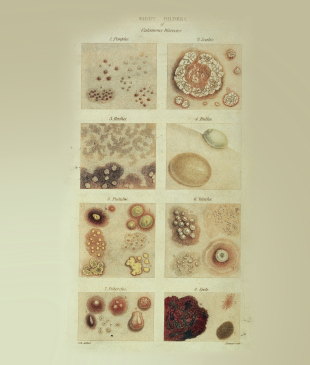Understanding Atopic Dermatitis Through the Ages

543
The word eczema is used to describe physical manifestations of AD.1
1660
Itch is defined as the unpleasant sensation that provokes the desire to scratch.2

1808
Skin diseases are categorized based on the lesion morphology.1,3

1845
Eczema is recognized as a relapsing and chronic condition
Eczema is acknowledged as a condition that experiences periods of improvement and recurrence over several months.1
1871
Acute and chronic eczema are differentiated, and infantile eczema is described
Clinical course of acute, chronic, and infantile eczema and their comorbidities are explained.1
1892
Eczema is the itch that rashes
Itch established as a first and central manifestation of eczema.4
1890-1892
Germs are postulated to contribute to AD
Eczema is believed to be caused by germs or chronic parasitic catarrh, treated by eliminating all germs in the deep skin layers.1
1892
Initial recognition of genetic predisposition in eczema
Ernest Besnier’s theory acknowledges the hereditary predisposition in people with eczema, linking it to food sensitivities and other systemic manifestations over time.1
1906
Allergic sensitization is first described
The concept of allergy is developed to represent altered reactivity to harmless substances.1
1923
Atopy is described and builds upon the concept of allergy
The concept of atopy, meaning without place, is developed.1
1933
The term Atopic Dermatitis is first coined
The term Atopic Dermatitis is developed to explain infantile eczema that develops in an individual with a family history of atopy.1
1980
Formal AD diagnostic criteria are developed
These criteria include 4 major features and various minor features, with the requirement that patients must show
≥3 major features AND ≥3 minor features to be diagnosed with AD.1
Major features are (1) pruritus, (2) personal or family history of atopy, (3) characteristic morphology and distribution, and (4) chronicity of lesions.1
Minor features include (1) early age of onset, (2) high levels of serum IgE, (3) existence of infraorbital lines,
(4) xerosis, and (5) hyperlinear palms.1
1997
Risk factors for AD development are identified
Risk factors are (1) history of pruritic skin changes, (2) personal history of asthma, (3) history of xerosis,
(4) visible flexural dermatitis, (5) history of flexural dermatitis, and (6) age of onset younger than 2 years.1
- Kramer ON, Strom MA, Ladizinski B, Lio PA. The history of atopic dermatitis. Clin Dermatol.2017;35(4):344-348. doi:10.1016/j.clindermatol.2017.03.005
- Siemens W, Xander C, Meerpohl JJ, et al. Pharmacological interventions for pruritus in adult palliative care patients. Cochrane Database Syst Rev. 2016;11(11):CD008320. doi:10.1002/14651858.CD008320.pub3
- Grzybowski A, Parish LC. Robert Willan: pioneer in morphology. Clin Dermatol. 2011;29(2):125-129. doi:10.1016/j.clindermatol.2010.09.005
- Taïeb A, Wallach D, Tilles G. The history of atopic eczema/dermatitis. In: Ring J, Przybilla B, Ruzicka T, eds.Handbook of Atopic Eczema. Springer; 2006.